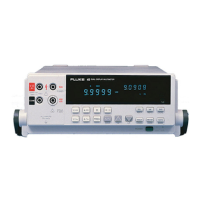General Maintenance
Introduction
3
3-3
3-1. Introduction
This provides handling, cleaning, fuse replacement, disassembly, and assembly
instructions.
3-2. Warranty Repairs and Shipping Information
If your meter is still under warranty, see the warranty information at the front of this
manual for instructions on returning the unit. A list of Fluke telephone numbers and our
website address can be found at the end of the warranty information and in Chapter 6.
3-3. General Maintenance Information
3-4. Required Equipment
Equipment required for calibration, troubleshooting, and repair of the Fluke 45 is listed
in Table 4-4.
3-5. Power Requirements
WWarning
To avoid shock hazard, connect the meter power cord to a
power receptacle with earth ground.
If you have not already done so, plug the line cord into the connector on the rear of the
meter. The meter operates on any line voltage between 90 V ac and 264 V ac without
adjustment, and at any frequency between 45 and 440 Hz. However, the meter is only
warranted to meet published specifications at 50/60 Hz. The meter draws a maximum of
15 VA.
3-6. Static Safe Handling
All integrated circuits, including surface mounted ICs, are susceptible to damage from
electrostatic discharge (ESD). Modern integrated circuit assemblies are more susceptible
to damage from ESD than ever before. Integrated circuits today can be built with circuit
lines less than one micron thick, allowing more than a million transistors on a 1/4-inch
square chip. These submicron structures are sensitive to static voltages under 100 volts.
This much voltage can be generated on a dry day by simply moving your arm. A person
can develop a charge of 2,000 volts by walking across a vinyl tile floor, and polyester
clothing can easily generate 5,000 to 15,000 volts during movement against the wearer.
These low voltage static problems are often undetected because a static charge must be
in the 30,000 to 40,000 volt range before a person will feel a shock.
Most electronic components manufactured today can be degraded or destroyed by ESD.
While protection networks are used in CMOS devices, they can only reduce, not
eliminate, component susceptibility to ESD.
ESD may not cause an immediate failure in a component; a delayed failure or
"wounding" effect is caused when the semiconductor’s insulation layers or junctions are
punctured. The static problem is thus complicated in that failure may occur anywhere
from two hours to six months after the initial damage.

